The entry-level Origin200 system, consisting of a maximum of two towers (up to four processors) that can be linked together.
The deskside/rackmount Origin2000 system, consisting of from 1 to 128 processors, housed in deskside and rackmount cabinets.
The Origin family is a revolutionary follow-on to the Challenge-class symmetric multiprocessing (SMP) system. It uses Silicon Graphics' distributed shared-memory multiprocessing architecture, called S2MP.
The development path of Silicon Graphics' multiprocessor systems is shown in Figure 1-1.
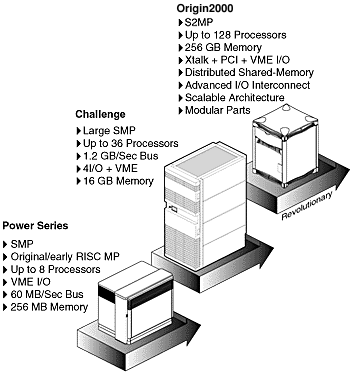
Developmental Path of Silicon Graphics Multiprocessing Architectures
Figure 1-2 is a block diagram of an Origin2000 system showing the central Node board, which can be viewed as a system controller from which all other system components radiate.
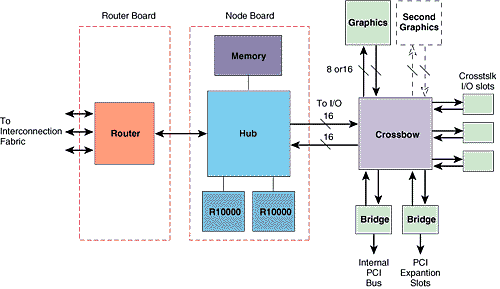
Origin2000 Block Diagram
Figure 1-3 is a block diagram of a system with four Node boards; Nodes 1 and 3 connect to Crossbow 1, and Nodes 2 and 4 connect to Crossbow 2. Crossbow 1 connects to XIO boards 1 through 6 and Crossbow 2 connects to XIO boards 7 through 12.
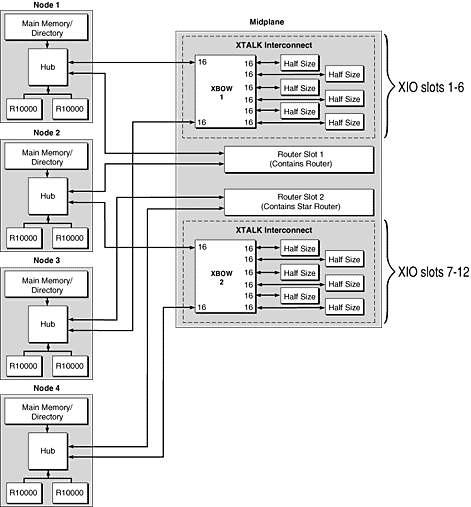
Block Diagram of a 4-Node System
The components shown in Figure 1-2 are described further in this chapter, in the section titled ``Origin2000 Components.''
As illustrated in Figure 1-4, Origin2000 is a number of processing nodes linked together by an interconnection fabric. Each processing node contains either one or two processors, a portion of shared memory, a directory for cache coherence, and two interfaces: one that connects to I/O devices and another that links system nodes through the interconnection fabric.
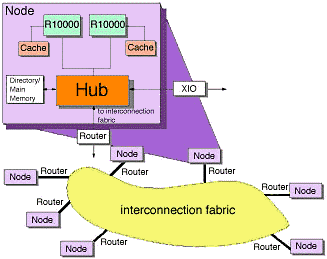
Nodes in an Origin2000 System
The interconnection fabric links nodes to each other, but it differs from a bus in several important ways. A bus is a resource that can only be used by one processor at a time. The interconnection fabric is a mesh of multiple, simultaneous, dynamically-allocable -- that is, connections are made from processor to processor as they are needed -- transactions. This web of connections differs from a bus in the same way that multiple dimensions differ from a single dimension: if a bus is a one-dimensional line, then the interconnection fabric is a multi-dimensional mesh.
Single Datapath Over a Bus
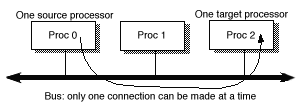
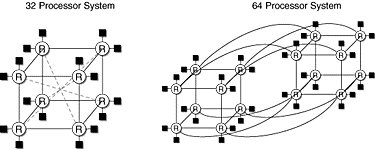
Multi-dimensional Datapaths Through an Interconnection Fabric
Origin2000 is said to be scalable, because it can range in size from 1 to 128 processors. As you add nodes, you add to and scale the system bandwidth. Origin2000 is also modular, in that it can be increased in size by adding standard modules to the interconnection fabric. The interconnection fabric is implemented on cables outside of these modules.
Origin2000 uses Silicon Graphics' new Scalable Shared-Memory
Multiprocessor (S2MP) architecture to distribute shared memory
amongst the nodes. This shared memory is accessible to all processors
through the interconnection fabric and can be accessed with low
latency.
Origin2000 Components
An Origin2000 system has the following components:
- processor(s)
memory
I/O controllers
distributed memory controller (Hub ASIC)
directory memory for cache coherence
CrayLink Interconnect
XIO and Crossbow interfaces
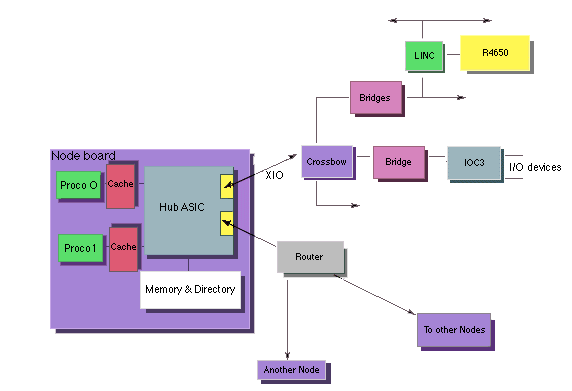
Components in an Origin2000 System
Processor
Origin2000 uses the MIPS R10000, a high-performance 64-bit superscalar processor which supports dynamic scheduling. Some of the important attributes of the R10000 are its large memory address space, together with a capacity for heavy overlapping of memory transactions -- up to twelve per processor in Origin2000.
Memory
Each Node board added to Origin2000 provides additional independantly accessed memory, and each node is capable of supporting up to 4 GB of memory. Up to 64 nodes can be configured in a system, which implies a maximum memory capacity of 256 GB.
I/O Controllers
Origin2000 supports a number of high-speed I/O interfaces, including Ultra, Fast, Wide SCSI, Fibrechannel, 100BASE-Tx, ATM, and HIPPI-Serial. Internally, these controllers are added through XIO cards, which have an embedded PCI-32 or PCI-64 bus. Thus, in Origin2000 I/O performance is added one bus at a time.
Hub
This ASIC is the distributed shared-memory controller. It is responsible for providing all of the processors and I/O devices a transparent access to all of distributed memory in a cache-coherent manner.
Directory Memory
This supplementary memory is controlled by the Hub. The directory keeps information about the cache status of all memory within its node. This status information is used to provide scalable cache coherence, and to migrate data to a node that accesses it more frequently than the present node.
CrayLink Interconnect
This is a collection of very high speed links and routers that is responsible for tying together the set of hubs that make up the system. The important attributes of CrayLink Interconnect are its low latency, scalable bandwidth, modularity, and fault tolerance.
XIO and Crossbow
These are the internal I/O interfaces originating in each Hub and
terminating on the targeted I/O controller. XIO uses the same
physical link technology as CrayLink Interconnect, but uses a
protocol optimized for I/O traffic. The Crossbow ASIC is a crossbar
routing chip responsible for connecting two nodes to up to six I/O
controllers.
What Makes Origin2000 Different
The following characteristics make Origin2000 different from previous
system architectures:
Origin2000 is modular.
Origin2000 uses an interconnection fabric to link system nodes and
internal crossbars within the system ASICs (Hub, Router,
Crossbow).
Origin2000 has distributed shared-memory and distributed shared-I/O.
Origin2000 shared memory is kept cache coherent using directories and
a directory-based cache coherence protocol.
Origin2000 uses page migration and replication to improve memory latency.
In contrast, traditional bus-based systems are only scalable in the
amount of its processing and I/O power. The Everest interconnect is
the E-bus, which has a fixed bandwidth and is the same size from
entry-level to high-end.
Modularity.
A system is comprised of standard processing nodes. Each node
contains processor(s), memory, a directory for cache coherence, an
I/O interface, and a system interconnection. Node boards are placed
in one of the following three types of system modules: entry-level,
deskside, or rack.
Traditional bus-based systems are not as modular; there is a fixed
number of slots in each deskside or rack system, and this number
cannot be changed.
System interconnections.
Origin2000 uses an interconnection fabric and crossbars. The
interconnection fabric is a web of dynamically-allocated
switch-connected links that attach nodes to one another. Crossbars
are part of the interconnection fabric, and are located inside
several of the ASICs--the Crossbow, the Router, and the Hub.
Crossbars dynamically link ASIC input ports with their output ports.
In traditional bus-based systems, processors access memory and I/O
interfaces over a shared system bus that has a fixed size and a fixed
bandwidth.
Distributed shared-memory (DSM) and I/O.
Origin2000 memory is physically dispersed throughout the system for
faster processor access. Page migration hardware moves data into
memory closer to a processor that frequently uses it. This page
migration scheme reduces memory latency -- the time it takes to
retrieve data from memory. Although main memory is distributed, it is
universally accessible and shared between all the processors in the
system. Similarly, I/O devices are distributed among the nodes, and
each device is accessible to every processor in the system.
Traditional bus-based systems have shared memory, but their memory is
concentrated, not distributed, and they do not distribute I/O. All
I/O accesses, and those memory accesses not satisfied by the cache,
incur extra latencies when traversing the bus.
Directory-based cache coherence.
Origin2000 uses caches to reduce memory latency. Cache coherence is
supported by a hardware directory that is distributed among the nodes
along with main memory. Cache coherence is applied across the entire
system and all memory. In a snoopy protocol, every cache-line
invalidation must be broadcast to all CPUs in the system, whether the
CPU has a copy of the cache line or not. In contrast, a directory
protocol relies on point-to-point messages that are only sent to
those CPUs actually using the cache line. This removes the
scalability problems inherent in the snoopy coherence scheme used by
bus-based systems such as Challenge. A directory-based protocol is
preferable to snooping since it reduces the amount of coherence
traffic that must be sent throughout the system.
Traditional bus-based systems use a snoopy coherence protocol.
Page migration and replication. To provide better performance
by reducing the amount of remote memory traffic, Origin2000 uses a
process called page migration. Page migration moves data that is
often used by a processor into memory close to that processor.
Traditional bus-based systems do not support page
migration.
Scalability and Modularity
Origin2000 scalability and modularity allow one to start with a small
system and incrementally add modules to make the system as large as
needed. An entry-level module can hold from one to four MIPS R10000
processors, and a Origin2000 deskside module can hold from one to
eight R10000 processors. A series of these deskside modules can be
mounted in racks, scaling the system up to the following maximum
configuration:
As one adds nodes to the interconnection fabric, bandwidth and
performance scale linearly without significantly impacting system
latencies. This is a result of the following design decisions:
System Interconnections
Origin2000 replaces traditional bus-based system's shared,
fixed-bandwidth bus with the following:
Interconnection Fabric
Origin2000 nodes are connected by an interconnection fabric. The
interconnection fabric is a set of switches, called routers, that are
linked by cables in various configurations, or topologies. The
interconnection fabric differs from a standard bus in the following
important ways:
The interconnection fabric provides a minimum of two separate paths
to every pair of Origin2000 nodes. This redundancy allows the system
to bypass failing routers or broken interconnection fabric links.
Each fabric link is additionally protected by a CRC code and a
link-level protocol, which retry any corrupted transmissions and
provide fault tolerance for transient errors.
Datapaths in an Interconnection Fabric
Crossbar
Several of the ASICs (Hub, Router, and Crossbow) use a crossbar for
linking on-chip inputs with on-chip output interfaces. For instance,
an 8-way crossbar is used on the Crossbow ASIC; this crossbar creates
direct point-to-point links between one or more nodes and multiple
I/O devices. The crossbar switch also allows peer-to-peer
communication, in which one I/O device can speak directly to another
I/O device.
The Router ASIC uses a similar 6-way crossbar to link its six ports
with the interconnection fabric, and the Hub ASIC links its four
interfaces with a crossbar. A logical diagram of a 4-way (also
referred to as four-by-four, or 4 x 4) crossbar is given in Figure 1-9; note that each output is
determined by multiplexing the four inputs.
Logical illustration of a Four-by-Four (4 x 4) Crossbar
Figure 1-10 shows a 6-way
crossbar at work. In this example, the crossbar connects six ports,
and each port has an input (I) and an output (O) buffer for flow
control. Since there must be an output for every input, the six ports
can be connected as six independent, parallel paths. The crossbar
connections are shown at two clock intervals: Time=n, and Time=n+1.
Crossbar Operation
At clock T=n, the ports independently make the following parallel connections:
Figure 1-10 shows the source
(Input) and target (Output) for each connection, and arrows indicate
the direction of flow. When a connection is active, its source and
target are not available for any other connection over the
crossbar.
At the next clock, T=n+1, the ports independently reconfigure
themselves into six new data links: 1-to-5, 2-to-4, 3-to-6, 4-to-1,
5-to-3 and 6-to-2. At clock intervals, the ports continue making new
connections as needed. Connection decisions are based on algorithms
that take into account flow control, routing, and arbitration.
Distributed Shared Address Space (Memory and
I/O)
Origin2000 memory is located in a single shared address space. Memory
within this space is distributed amongst all the processors, and is
accessible over the interconnection fabric. This differs from a
traditional bus-based system, in which memory is centrally located on
and only accessible over a single shared bus. By distributing
Origin2000's memory among processors memory latency is reduced:
accessing memory near to a processor takes less time than accessing
remote memory. Although physically distributed, main memory is
available to all processors.
I/O devices are also distributed within a shared address space; every
I/O device is universally accessible throughout the system.
Origin2000 Memory Hierarchy
Memory in Origin2000 is organized into the following hierarchy:
Memory Hierarchy, Based on Relative Latencies and Data Capacities
Caches are used to reduce the amount of time it takes to access
memory -- also known as a memory's latency -- by moving faster
memory physically close to, or even onto, the processor. This faster
memory is generally some version of static RAM, or SRAM.
The DSM structure of Origin2000 also creates the notion of local
memory. This memory is close to the processor and has reduced latency
compared to bus-based systems, where all memory must be accessed
through a shared bus.
While data only exists in either local or remote memory, copies of
the data can exist in various processor caches. Keeping these copies
consistent is the responsibility of the logic of the various hubs.
This logic is collectively referred to as a cache-coherence
protocol.
System Bandwidth
There are three types of bandwidths:
Table 1-1..............................Peak and
Sustained Bandwidths
Table 1-2..............................System Bisection
Bandwidths
Origin2000 is scalable.
Scalability. Origin2000 is easily scaled by linking nodes together over
an interconnection fabric, and system bandwidth scales linearly with an
increase in the number of processors and the associated switching fabric.
This means Origin2000 can have a low entry cost, since you can build a system
upward from an inexpensive Origin200 configuration.
These internal crossbars maximize the throughput of the major system
components and concurrent operations.
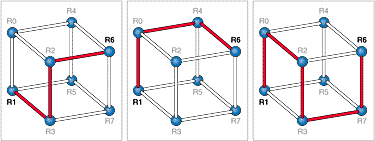
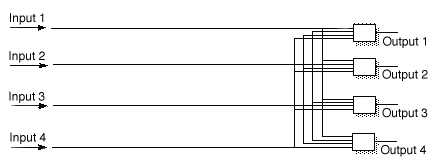
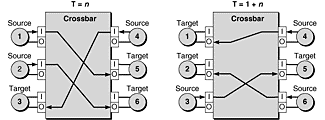
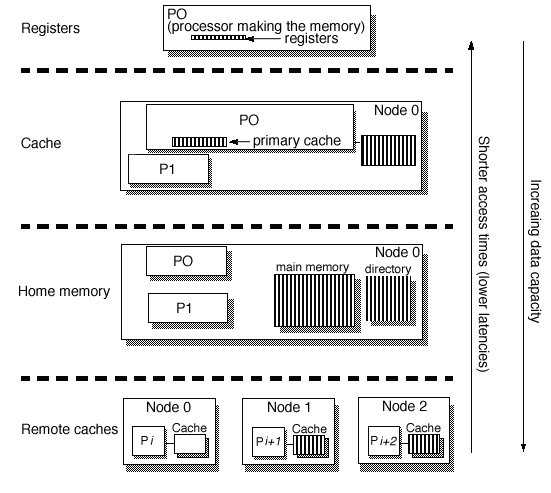
Table 1-1 gives a comparison
between peak and sustained data bandwidths of Origin2000.
_______________________________________________________
Table 1-2 lists the bisection
bandwidths of various Origin2000 configurations both with and without
Express Links.
Interface Sustained Bandwidth
[Peak BW in brackets]
______________________________________________________
Memory 780 MB per second [780]
______________________________________________________
Node Card 1.25 GB per second [1.56 GB]
______________________________________________________
Crossbow 2.5 GB per second [3.12 GB]
______________________________________________________
Module (deskside) 5.0 GB per second [6.24 GB]
______________________________________________________
Rack 80 GB per second [100 GB]
______________________________________________________
Table 1-3 lists the bandwidths
of Ultra SCSI and FibreChannel devices.
_______________________________________________________________________________________
System Size Sustained Bisection Bandwidth Sustained Bisection Bandwidth
(number of CPUs) without Express Links [Peak BW] with Express Links [Peak BW]
_______________________________________________________________________________________
8 1.25 GB per second [1.56 GB] 2.5 GB per second [3.12 GB]*
_______________________________________________________________________________________
16 2.5 GB per second [3.12 GB] 5.0 GB per second [6.24 GB]
_______________________________________________________________________________________
32 5.0 GB per second [6.24 GB] 10 GB per second [12.5 GB]
_______________________________________________________________________________________
64 10 GB per second [12.5 GB] N/A
_______________________________________________________________________________________
128 20 GB per second [25.0] N/A
_______________________________________________________________________________________
* With Star Router
| Table 1-3 | Peripheral Bandwidths | |
| _______________________________________________ | ||
| Peripheral | Bandwidth | |
| _______________________________________________ | ||
| Ultra SCSI | 40 MB per second | |
| _______________________________________________ | ||
| FibreChannel | 100MB per second | |
| _______________________________________________ | ||